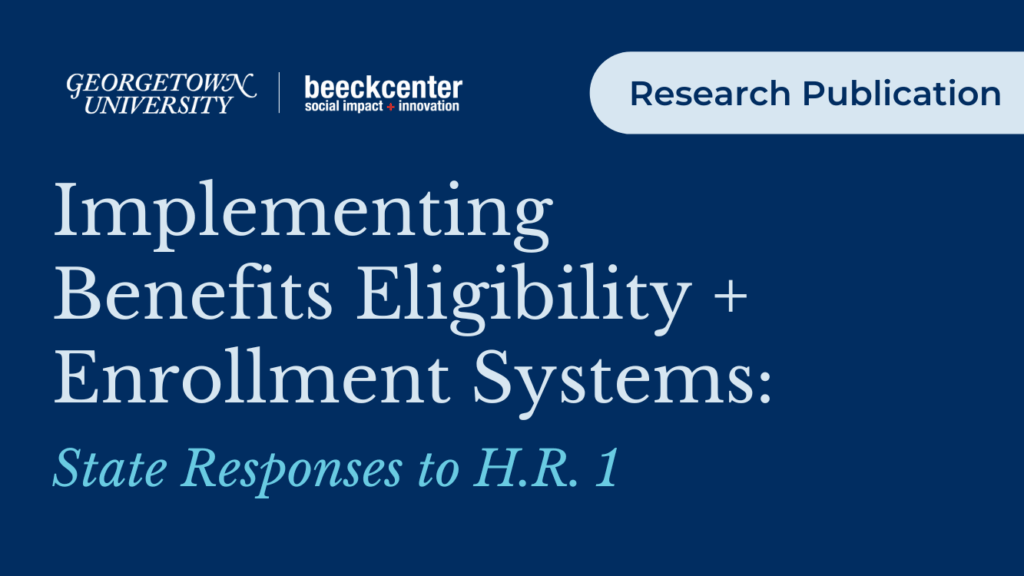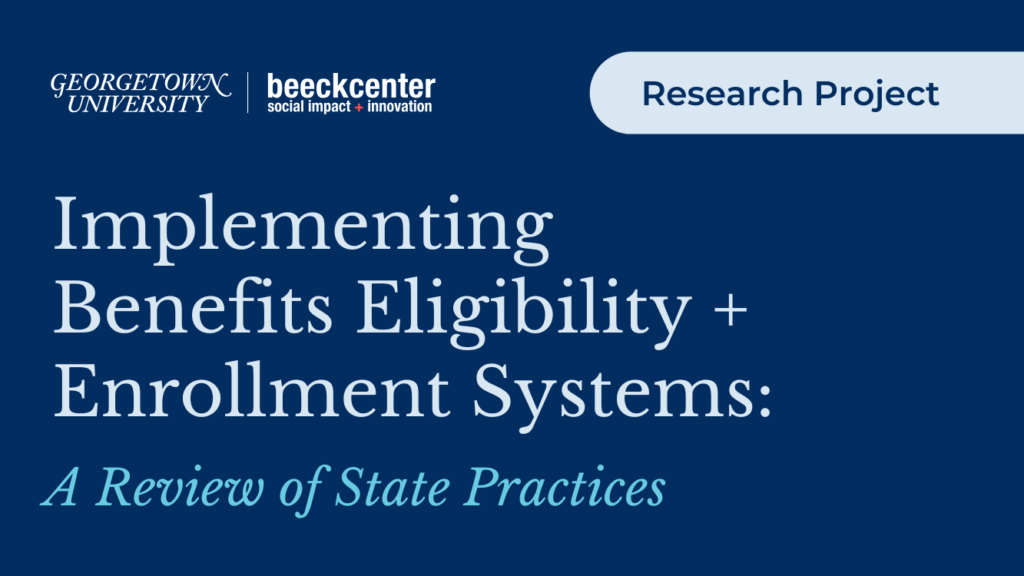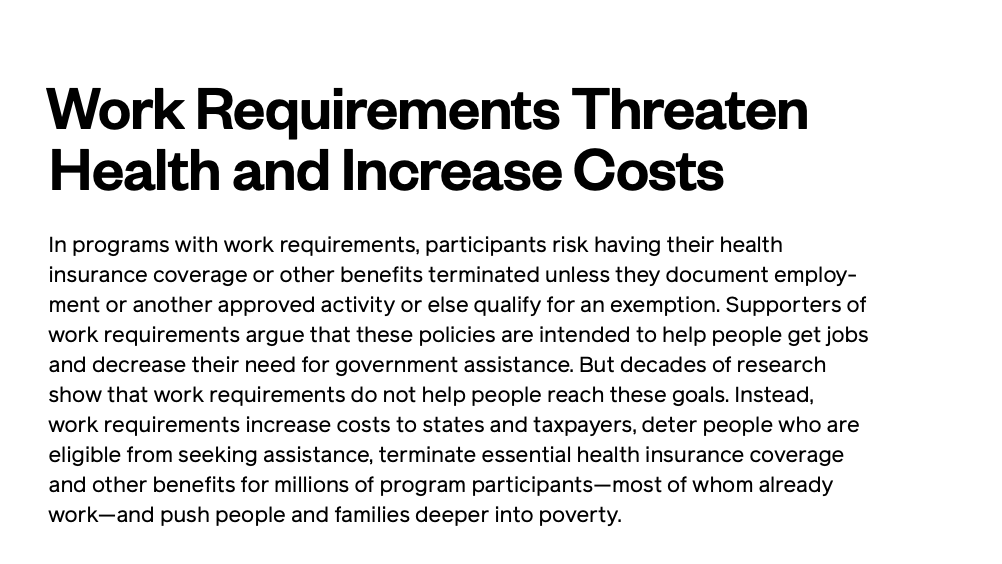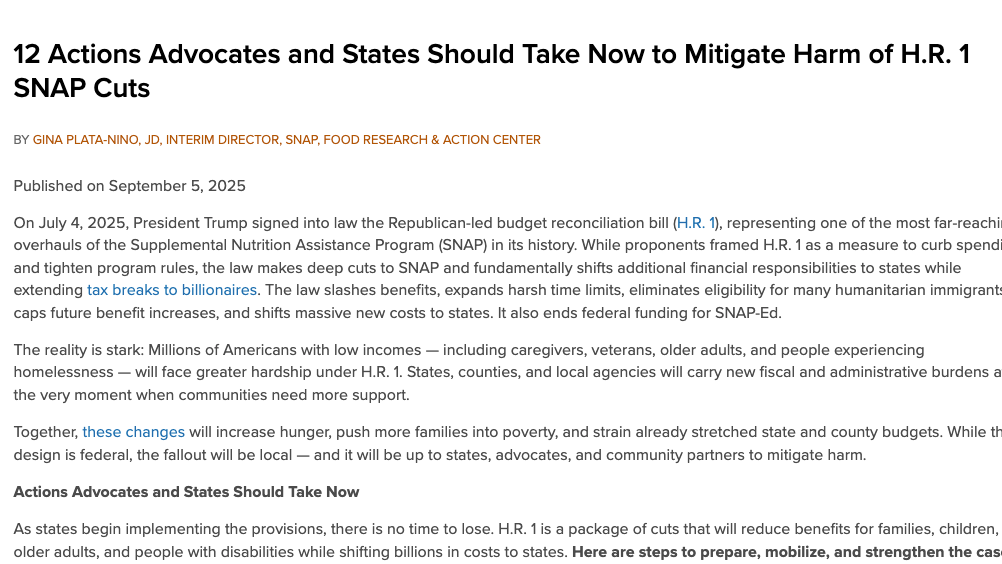Implementing Benefits Eligibility + Enrollment Systems: State Responses to H.R. 1
This report summarizes insights from interviews with seven states on how they are adapting integrated eligibility and enrollment (IEE) systems in response to sweeping federal changes to SNAP and Medicaid under H.R. 1.

Introduction
Throughout summer 2025, our team at the Digital Benefits Network at the Beeck Center for Social Impact + Innovation at Georgetown University conducted interviews with leaders from seven states. These states operate, or are building, integrated eligibility and enrollment (IEE) systems for core public benefit programs such as the Supplemental Nutrition Assistance Program (SNAP), Medicaid, Temporary Assistance for Needy Families (TANF), and child care. Under our research protocol, we are not disclosing which states we spoke to or attributing specific information or quotes. The interviews were conducted shortly after the passage of H.R. 1, the One Big Beautiful Bill Act in July 2025, following months of other federal changes.
As part of our research, we asked state leaders a key question about how they were adapting their systems to federal changes. A majority of the leaders focused on impacts to SNAP and Medicaid from H.R. 1 which are facing historic coverage losses and increase in state costs:
- It is estimated that 10 million people will lose Medicaid coverage by 2034 under the new provisions, including new work requirements.
- It is estimated that 22.3 million families will lose some or all of their SNAP benefits.
- For the first time, states are required to pay 75 percent of SNAP administrative costs, rather than 50 percent.
- For states with SNAP payment error rates over 6 percent, H.R. 1 shifts 5 to 15 percent of benefits costs to states.
- Under H.R. 1, SNAP costs will rise in all states, but some states will face 50 to 768 percent increases in total costs, if they choose to continue to offer the program at the current enrollment levels. These increases range from tens of millions to over $1 billion dollars in large states like New York, California, and Florida. These costs will cause states to change their eligibility requirements, benefit amounts, or exit the program.
These impacts are compounded by many states already facing budget shortfalls before H.R. 1, as well as competing priorities from their state legislatures. States are starting to publish independent summaries of impacts on their residents and budget requests for implementation of H.R. 1 changes. (See a collection of these summaries on the Hub).
Below, we summarize seven key insights from our interviews with states, bolstered by additional research and supporting sources. These insights illustrate themes in how states are responding to H.R. 1 as they manage the policy and technology changes in their integrated eligibility and enrollment systems.

This publication is part of a series on Implementing Benefits Eligibility + Enrollment Systems. Learn more about our research and follow for updates on upcoming publications.
Insight 1: Awaiting Federal Guidance
States are awaiting policy implementation guidance from federal agencies.
States are awaiting guidance from the U.S. Department of Agriculture Food and Nutrition Service (USDA FNS) for SNAP and the U.S. Department of Health and Human Services Centers for Medicare and Medicaid Services (HHS CMS) for Medicaid. H.R. 1 provision effective dates run across a multi-year timeline, with some effective upon enactment, and others over the course of years. Without initial guidance, states are left to interpret the provisions for themselves and plan for potential reworks.
In September 2025, FNS began publishing initial H.R. 1 guidance on a dedicated page. On October 3, 2025, FNS added policy memos on work requirements for able-bodied adults without dependents (ABAWDs), which were enacted with the bill signing on July 4, 2025. States were held harmless for 120 days from enactment, meaning that the changes must be in place as of November 1, 2025, less than a month after the memos were released in early October. As of publication of this research, FNS has not included additional information on major changes such as updates to eligibility for groups with different legal immigration statuses or details on matching funds or administrative cost-sharing. States we spoke with also shared frustration in delays to the FNS’ standard annual updated guidance, on which states depend to inform system changes. One state cited the delay this year in receiving the SNAP benefit allotment on the Thrifty Food Plan, which was issued in mid-August rather than early August, only leaving about six weeks for implementation by October 1. Additionally, states have cited delays in getting approvals from FNS for other annual updates such as the Standard Utility Allowance (SUA) values, for which they are unable to implement accurate values without approval.
H.R. 1 directs CMS to issue a final rule on Medicaid work requirements by June 1, 2026, leaving states until December 31, 2026 for implementation. In Insight 3, we share more about how states are preparing for these changes.
States are continuing to engage with federal agencies around routine processes, such as submitting their Advanced Planning Documents (APDs) to USDA and HHS. One state reported that recent APDs have been approved, and others are getting automatically approved after the 60-day review window has passed. For upcoming submissions, states are trying to understand expectations and requirements and submit well ahead of deadlines where possible.
Both USDA and HHS are undergoing significant structural and staffing changes which may be impacting engagement with states. In March 2025, HHS proposed a reorganization plan which includes reducing staff by 20,000 through a combination of deferred resignations and reductions in force, restructuring agencies, and the number of regions. The HHS reorganization was stalled by a legal action, which as of September 2025 continues to be blocked by the court. More than 15,000 USDA employees accepted deferred resignation in the first half of 2025. In July 2025, USDA announced a proposed reorganization of the department, which includes reducing the number of FNS regions, relocating staff, and consolidating roles and office responsibilities.
Insight 2: Collaborative Work Groups
States are standing up cross-functional and cross-agency work groups to assess impact, interpret policy, and plan for implementation.
States are taking different approaches to structuring their work groups. Some states are creating federal response work groups at the governor’s office or cabinet level. Others are bringing together different functional teams within their agency, such as technology, policy, and business. One state noted this type of cross-team work as a shift in their approach—they are doing assessment upfront in the cross-functional work group rather than sending the business unit to figure it out by themselves. Other states are creating workgroups that extend beyond their agency for cross-agency collaboration and understanding priorities and impacts.
Another state shared they were hosting a cross-agency event to problem solve around key questions in implementing work requirements, such as impacts to the customer flow, what the state has to do in terms of reporting data-gathering and monitoring system changes, and how to best engage community-based organizations and Tribal governments.
States also shared feeling uncoordinated even with work groups in place, given how inundated they are with the needed analysis.
“It’s almost like you can’t even get a full answer to one question before you’re already trying to answer the next.”
State Leader
Insight 3: Road Map Placeholders
States are putting placeholders on their technology road maps because they know they will need to implement changes, while deprioritizing other changes and fixes.
To ensure they have the correct updates to their IEE systems in place before H.R. 1’s compliance dates, states are adding placeholders for system updates and change requests on their road maps. For instance, in December 2026, one state is planning a release to meet H.R. 1’s requirement to implement Medicaid work requirements by December 31, 2026. Another state will have to adjust its road map for at least the next year. States are deprioritizing or “placing on the backlog” many enhancements that were previously planned. For instance, one state is deprioritizing its efforts to ensure its mobile benefit enrollment application meets all accessibility standards to prioritize H.R. 1-related changes.
With placeholders set, states are working backwards to determine the steps, personnel, and funding needed to comply with H.R. 1’s requirements by the federal deadlines. At least one state is already working on updates to its IEE, starting with changes to its SNAP expense verification screens, and creating change requests with their vendor to track future updates. Another state expressed that it is cautiously making changes to its system in case any H.R. 1 requirements are rescinded by Congress or overturned by a court. That state is also looking into how it can reuse previous system investments and updates, such as by repurposing the changes it made for SNAP work requirements for able-bodied adults without dependents to enact the Medicaid work requirements.
Insight 4: SNAP Payment Error Rate are Top Priority
Some states are prioritizing reducing their SNAP payment error rates to protect against new cost sharing requirements.
For the first time in the history of the SNAP program, H.R. 1 has the potential to shift the cost of SNAP benefits to states. States with payment error rates over 6 percent will be newly required to pay a percentage of SNAP benefits costs. H.R. 1 stipulates that states contribute different amounts of benefits costs—between 5 and 15 percent—and sets different start dates (fiscal years 2028-2030) for those contributions based on states’ error rates. In an effort to protect SNAP funding, several states are focusing on improving their SNAP error rates over and above other potential priorities.
Our colleagues at the Georgetown Center on Poverty and Inequality created this helpful map to show projected pre-and post-H.R. 1 SNAP cost share amounts.
To support this effort, states are assessing their error rates and causes, cost impacts, and timelines. However, multiple states shared that they did not have data between annual fiscal year FNS reporting to further assess their current error rate. States are also increasingly making hard choices between expanding access to SNAP and reducing their error rates. Several states are continuing to prioritize helping as many people as possible qualifying for SNAP, while others are shifting staff traditionally focused on outreach and enrollment to error rate reduction activities.
Notably, several governors made reducing SNAP payment error rates a priority in August and September 2025. In Virginia, Governor Glenn Youngkin issued a directive to reduce the commonwealth’s current error rate of 11.5 percent to below 6 percent through training, additional verifications, quality control improvements, and technology. In California, the state legislature recently passed a bill signed into law by Governor Gavin Newsom that appropriates $3.2 million dollars from the general fund to the California Department of Social Services “for automation related to CalFresh payment error rate mitigation and implementation of federal H.R. 1.”
Insight 5: Making Changes in End-of-Life Systems
Implementing changes in end-of-life systems will be costly and intensive, complicating states’ plans to replace them.
Several states have older IEE systems, which are operating with significant “tech debt.” These aging systems have built-up issues accumulated over many years and require major investments to modernize. Some states are spending tens of millions of dollars annually to keep these systems running. Making changes in these systems is intensive and more complicated than in a modernized system because the code in one area of the system affects many others. Some states are in the process of replacing their “end-of-life” systems, with launch timelines concurrent with or after H.R. 1 effective dates, causing states to question making changes in multiple systems.
If states that are replacing their systems have to make changes in their current older systems to comply with H.R. 1, they may have to pay for the work to enact these changes twice. Meanwhile, H.R. 1’s reduction of the federal-state match rate for SNAP administration from 50 percent to 25 percent, as well as its elimination of enhanced funding for Medicaid system changes, significantly reduces states’ budgets for both making the required changes and enhancing or replacing their systems at a time when many states are already seeing their budgets stretched.
Many states rely on vendors to maintain and update their IEE systems. There are few vendors in this space, and states frequently contract with vendors for a five- to ten-year period. As states continue to ask vendors to make updates to their outdated systems, the vendors accumulate more of the knowledge about how those systems run, which further ties states to their contracts with the vendors. Due to this entrenchment, vendors have limited incentive to innovate, which contributes to these systems becoming outdated. States will also largely rely on vendors to make changes included in H.R. 1, often with a high cost for each change request.
“The last time (our IEE system) was put out for re-procurement, this incumbent vendor was the only vendor that bid. So, we've been with the same vendor for over 15 years, and that's created this situation where a lot of the knowledge about the system resides with them. And then also, you know, the system itself is sort of what gets built up over 15 years with the same vendor.”
State Leader
Insight 6: Rethinking Data Sharing
The Trump administration’s unprecedented requests for program data have caused some states to rethink how they use and store data for IEE systems.
To run IEEs, many states share data between state agencies that run different programs, such as between the agencies that run the states’ SNAP and Medicaid programs. For instance, several states have a “master person index” that allows for them to share an applicant’s record and information. This allows states to more efficiently enroll applicants in multiple programs and reduces the burden placed on applicants when providing information.
“When you know person X is already in system A and person X is applying, we can pull the information from system A without necessarily having to ask (person X) to fill it out again.”
State Leader
However, some states are starting to reconsider the risk of co-locating data, particularly in light of the Trump administration providing Medicaid recipients’ data to U.S. Immigration Customs and Enforcement (ICE) and requesting SNAP enrollee data from states and vendors. Both of these data requests have faced legal challenges and courts have paused action through injunctions in many states.
“Having data co-located in one database presents risks. It presents risks when the tone and tenor of federal partners changes… I think we've learned that we have to be more mindful about how we are walling off different programs. While things seem like, from a streamlined efficiency perspective, you should put things all in one area, there [are] inherent risk to that. And those risks have real consequences.”
State Leader
Insight 7: Considering Population Impacts + Experiences
States are assessing how policy changes impact the experiences of specific populations across the range of effective dates.
H.R. 1 has significant impact on certain populations. For example, SNAP work requirements for ABAWDs changed the ages impacted from 18-54 to 18-64 and removed the exemptions for homeless individuals, veterans, and youth exiting foster care. Furthermore, many previously eligible immigrant status groups are no longer eligible for SNAP, while in Medicaid, those eligible under modified adjusted gross income (MAGI) now require renewals every six months instead of annually. The changes also have a variety of effective dates, which are likely to cause confusion for both staff and beneficiaries. States view this as a particular challenge for IEEs, as caseworkers review and process applications from multiple programs.
Several states are thinking about people’s experiences in human-centered ways. They are considering how changes cascade over time for individuals, and also within families who may be impacted in multiple ways, based on differences in each household member’s circumstances. One state shared that they are trying to map and test out where beneficiaries may experience conflicting outcomes when redetermining their SNAP and Medicaid eligibility, so that they can try to mitigate harmful impacts. Another state views implementing H.R. 1 as an opportunity to modernize their technology to streamline how families experience the impacts as well as stay responsive to future federal changes.
We are continuing to closely follow H.R. 1 developments as federal guidance rolls out and states begin implementation. The policy and technology changes will cause significant shifts in state eligibility and enrollment systems and impacts on the people they serve. States will need innovative solutions and strong partnerships with implementers and community organizations to ensure a less harmful transition.
Get in Touch
As your state works to implement H.R. 1, the Digital Benefits Network is here to help. We are able to connect you to peer state leaders, to nonprofits seeking collaboration, and to the latest resources and research on the H.R. 1 Implementation Hub page. Get in touch at digitalbenefits@georgetown.edu.
Stay tuned for the next publications in our Implementing Benefits Eligibility + Enrollment series. Subscribe to receive updates.
Acknowledgments
Thank you to the state leaders who spoke with us about their IEE systems and how they are responding to federal changes.
A special thanks to Elizabeth Bynum Sorrell for her research and synthesis coaching and support. Thank you to Sabrina Toppa for copy editing.
Citation
Cite as:
Ariel Kennan and Jason Goodman, “Implementing Benefits Eligibility + Enrollment Systems: State Responses to H.R. 1,” Digital Benefits Network at the Beeck Center for Social Impact + Innovation, October 10, 2025, https://digitalgovernmenthub.org/publications/implementing-benefits-eligibility-enrollment-systems-state-responses-to-h-r-1/.


